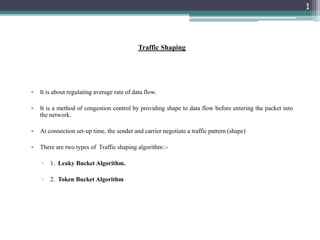
Leaky Bucket & Tocken Bucket - Traffic shaping
- 1. 1 Traffic Shaping • It is about regulating average rate of data flow. • It is a method of congestion control by providing shape to data flow before entering the packet into the network. • At connection set-up time, the sender and carrier negotiate a traffic pattern (shape) • There are two types of Traffic shaping algorithm :- ▫ 1. Leaky Bucket Algorithm. ▫ 2. Token Bucket Algorithm
- 2. 2 Leaky Bucket Algorithm • The Leaky Bucket Algorithm used to control rate in a network. • It is implemented as a single-server queue with constant service time. • If the bucket (buffer) overflows then packets are discarded. • In this algorithm the input rate can vary but the output rate remains constant. • This algorithm saves busty traffic into fixed rate traffic by averaging the data rate.
- 3. 3 The Leaky Bucket Algorithm (a) A leaky bucket with water. (b) a leaky bucket with packets.
- 4. 4 Leaky Bucket Algorithm Algorithm Step - 1 : Initialize the counter to ‘n’ at every tick of clock. Step - 2 : If n is greater than the size of packet in the front of queue send the packet into the network and decrement the counter by size of packet. Repeat the step until n is less than the size of packet. Step - 3 : Reset the counter and go to Step - 1.
- 5. 5 Example Let n = 1000 Packet =. 200 700 500 450 400 200 Since n > front of Queue i.e. n>200 Therefore, n= 1000-200 = 800 Packet size of 200 is sent to the network 200 700 500 450 400 Now Again n > front of queue i.e. n > 400 Therefore, n= 800-400 = 400 Packet size of 400 is sent to the network 200 700 500 450 Since n < front of queue . There fore, the procedure is stop. And we initialize n = 1000 on another tick of clock. This procedure is repeated until all the packets is sent to the network.
- 6. 6 Leaky Bucket Algorithm Example Consider a frame relay network having a capacity of 1Mb and data is input at the rate of 25mbps.Calculate 1. What is the time needed to fill the bucket. 2. If the output rate is 2 mbps , the time needed to empty the bucket. Ans. Here , C is Capacity of bucket = 1mb Data input rate = 25 mbps output rate = 2mbps. 1. T = C/input rate = 1/25 = 40 msec 2 T = C/output rate = ½ = 500 msec
- 7. 7 Token Bucket Algorithm • The Token Bucket Algorithm compare to Leaky Bucket Algorithm allow the output rate vary depending on the size of burst. • In this algorithm the buckets holds token to transmit a packet, the host must capture and destroy one token. • Tokens are generated by a clock at the rate of one token every t sec. • Idle hosts can capture and save up tokens (up to the max. size of the bucket) in order to send larger bursts later.
- 8. 8 Token Bucket Algorithm 5-34 (a) Before (b) After
- 9. 9 Token Bucket Algorithm Algorithm Step - 1 : A token is added at every ∆t time. Step - 2 : The bucket can hold at most b-tokens. If a token arrive when bucket is full it is discarded. Step - 3 : When a packet of m bytes arrived m tokens are removed from the bucket and the packet is sent to the network. Step – 4 : If less than n tokens are available no tokens are removed from the buckets and the packet is considered to be non conformant. The non conformant packet may be enqueued for subsequent transmission when sufficient token have been accumulated in the bucket. If C is the maximum capacity of bucket and ρ is the arrival rate and M is the maximum output rate then Burst Length S can be calculated as C + ρS = MS
- 10. 10 Token Bucket Algorithm Example Consider a frame relay network having a capacity of 1Mb of data is arriving at the rate of 25mbps for 40msec.The Token arrival rate is 2mbps and the capacity of bucket is 500 kb with maximum output rate 25mbps.Calculate 1. The Burst Length. 2. Total output time. Ans. Here , C is Capacity of bucket = 500kb M= 25 mbps ρ = 2mbps. 1. S= 500/((25-2)*1000) = 21.73msec ~= 22msec 2 For 22msec the output rate is 25msec after that the output rate becomes 2mbps i.e. token arrival rate. Therefore, for another 500 kb the time taken will be. 500/(2000) = 250 msec Therefore, total output time = 22 +250 = 272 msec.
- 11. 11 DIFFERENCE BETWEEN LEAKY BUCKET AND TOKEN BUCKET ALGORITHM TOKEN BUCKET LEAKY BUCKET Token dependent. Token independent. If bucket is full token are discarded, but not the packet. If bucket is full packet or data is discarded. Packets can only transmitted when there are enough token Packets are transmitted continuously. It allows large bursts to be sent faster rate after that constant rate It sends the packet at constant rate It saves token to send large bursts. It does not save token.
